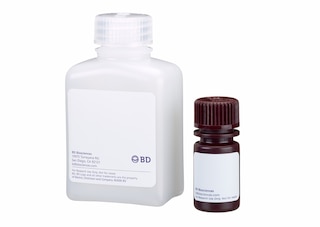-
Your selected country is
Middle East / Africa
- Change country/language
Old Browser
This page has been recently translated and is available in French now.
Looks like you're visiting us from {countryName}.
Would you like to stay on the current country site or be switched to your country?




Flow cytometric analysis of Foxp3 expression in BALB/c mouse splenocytes. Splenocytes from BALB/c mice were fixed and permeabilized using working solutions of Mouse Foxp3 Buffers (Mouse Foxp3 Buffer Set, Cat. No. 560409). The cells were then stained with PE Rat anti-Mouse CD4 (Cat. No. 553048) and BD Horizon™ V450 Rat anti-Mouse FoxP3 antibodies (Cat. No. 561293). The flow cytometric dot plot shows the correlated expression of CD4 versus Foxp3 for gated events with the forward and side light-scattering characteristics of viable lymphocytes. Flow cytometry was performed using a BD™ LSR II Flow Cytometry System.


BD Horizon™ V450 Rat Anti-Mouse Foxp3

Regulatory Status Legend
Any use of products other than the permitted use without the express written authorization of Becton, Dickinson and Company is strictly prohibited.
Preparation And Storage
Recommended Assay Procedures
BD® CompBeads can be used as surrogates to assess fluorescence spillover (compensation). When fluorochrome conjugated antibodies are bound to BD® CompBeads, they have spectral properties very similar to cells. However, for some fluorochromes there can be small differences in spectral emissions compared to cells, resulting in spillover values that differ when compared to biological controls. It is strongly recommended that when using a reagent for the first time, users compare the spillover on cells and BD® CompBeads to ensure that BD® CompBeads are appropriate for your specific cellular application.
Product Notices
- Since applications vary, each investigator should titrate the reagent to obtain optimal results.
- Please refer to www.bdbiosciences.com/us/s/resources for technical protocols.
- Caution: Sodium azide yields highly toxic hydrazoic acid under acidic conditions. Dilute azide compounds in running water before discarding to avoid accumulation of potentially explosive deposits in plumbing.
- For fluorochrome spectra and suitable instrument settings, please refer to our Multicolor Flow Cytometry web page at www.bdbiosciences.com/colors.
- BD Horizon V450 has a maximum absorption of 406 nm and maximum emission of 450 nm. Before staining with this reagent, please confirm that your flow cytometer is capable of exciting the fluorochrome and discriminating the resulting fluorescence.
- Please refer to http://regdocs.bd.com to access safety data sheets (SDS).
- Pacific Blue™ is a trademark of Life Technologies Corporation.
Companion Products


.png?imwidth=320)
Foxp3 is a 50-55 kDa protein also known as Forkhead box P3, JM2, or IPEX. It is a member of the forkhead or winged helix family of
transcription factors and is specifically expressed by T regulatory (Treg) cells. Foxp3 has been reported to be a key regulatory protein for Treg
cell development and function. Ectopic expression of Foxp3 in conventional T cells is sufficient to induce suppressive activity, repress the
production of cytokines such as IL2 and IFN-γ, and upregulate Treg cell-associated molecules such as CD25, CTLA4 and GITR. It has been
found that the mutation of Foxp3 is responsible for "scurfy" mice. When overexpressed, Foxp3 leads to poor T cell proliferation and
activation

Development References (3)
-
Hori S, Nomura T, Sakaguchi S. Control of regulatory T cell development by the transcription factor Foxp3. Science. 2003; 299(5609):1057-1061. (Biology). View Reference
-
Ono M, Yaguchi H, Ohkura N, et al. Foxp3 controls regulatory T-cell function by interacting with AML1/Runx1. Nature. 2007; 446(7136):685-689. (Biology). View Reference
-
Zheng Y, Rudensky AY. Foxp3 in control of the regulatory T cell lineage. Nat Immunol. 2007; 8:457-462. (Biology). View Reference
Please refer to Support Documents for Quality Certificates
Global - Refer to manufacturer's instructions for use and related User Manuals and Technical data sheets before using this products as described
Comparisons, where applicable, are made against older BD Technology, manual methods or are general performance claims. Comparisons are not made against non-BD technologies, unless otherwise noted.
For Research Use Only. Not for use in diagnostic or therapeutic procedures.
Report a Site Issue
This form is intended to help us improve our website experience. For other support, please visit our Contact Us page.